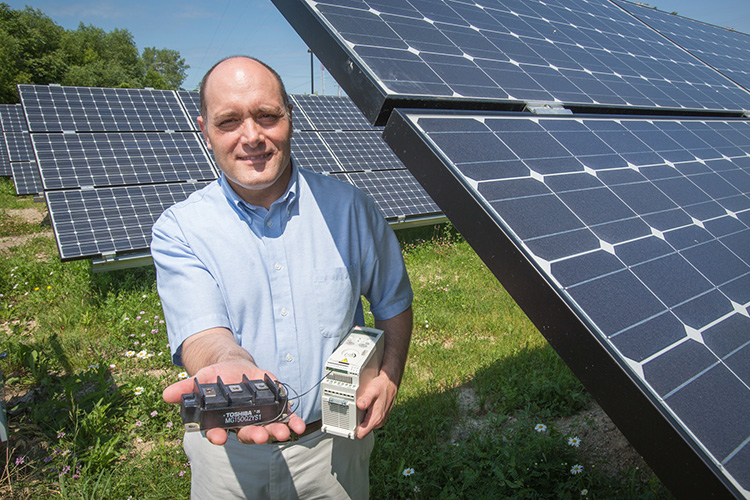Since Nikola Tesla and George Westinghouse won the war of currents 125 years ago, almost all buildings in the U.S. are designed to use electricity in AC, or alternating current. But technologies have advanced, making the more efficient DC, or direct current, feasible.
Converting just some devices and fixtures in your home to DC could reduce your power bill by up to two-thirds. Rob Cuzner, assistant professor of electrical engineering, explains the science behind a neighborhood microgrid and how this new technology combined with smart DC-enabled homes can happen in lower-income neighborhoods that really need them. (Cuzner will participate in the “Big Ideas for Busy People” program on Saturday at the Wisconsin Science Festival.)
Why go to the trouble of making changes to accommodate DC?
DC is far more efficient than AC and, with a new technology called a microgrid and internet of things applications, a group of households can share renewable energy sources, making green energy more affordable. Also, with a neighborhood microgrid residents can easily see how to conserve energy based on feedback the system provides on their differing energy-use habits.
What’s a microgrid?
Microgrids are essentially micro-utilities for a limited area, like a neighborhood, that can operate independently of the big utilities by sharing power coming from multiple renewable sources and energy storage.
Until now, storing electricity from green sources has been a challenge, so the power generated had to be used immediately. But a microgrid solves the problem by smoothing out power from an intermittent stream by storing some of it and integrating supply and demand through intelligent controls.
How will you test this?
We hope to have a working testbed in Milwaukee. We are working with Howard Snyder of the Northwest Side Community Development Corp., which has procured vacant houses in the Garden Homes neighborhood around 27th Street and Capitol Drive. We want to slowly renovate the houses, starting with a cluster of five houses, to accept DC and link them all to a microgrid.
A five-year living laboratory project will teach residents how to interact with the microgrid and smart DC power appliances and fixtures in their homes in order to drive down their utility costs significantly.
With a project like this, residents in a microgrid community become stakeholders. University researchers will involve a local STEM high school and help the community become familiar with smart inter-connected energy systems and to ensure sustainability.
So how does this save money?
Residents share the renewable energy that they generate among themselves to offset the amount they draw from the electrical grid. Then, during peak hours, when electricity from the grid is most expensive, the group of users can go off the grid and rely on its collective stored energy.
There’s also a feedback component. By using a secure cloud-based system and apps that will be developed for use on smart phones, tablets and computers, participants can learn how to manage their energy usage and change their habits to increase energy savings over time.
Meanwhile, the microgrid has its own autonomous controls that enable it to self-optimize. Residents may choose to increase their energy savings by allowing more direct communication between the microgrid and their appliances and fixtures.
So this is something that would benefit every homeowner?
Yes. But the system offers much more to lower-income residents. As it stands now, they spend 16 percent of their income on utilities, compared to 3 percent for the middle class. They have the most to gain from renewables, but would be the last ones to adopt the technology because of installation costs.








